In the ever-evolving landscape of online learning, finding the right Learning Management System (LMS) can be a game-changer.
Skool has emerged as a standout platform, blending comprehensive course management with robust community engagement and gamification features.
This 2024 review dives deep into what makes Skool unique, exploring its key functionalities, user experiences, and how it compares to other LMS options.
Whether you’re an educator, course creator, or business, discover how Skool can elevate your online learning experience.
What is Skool?
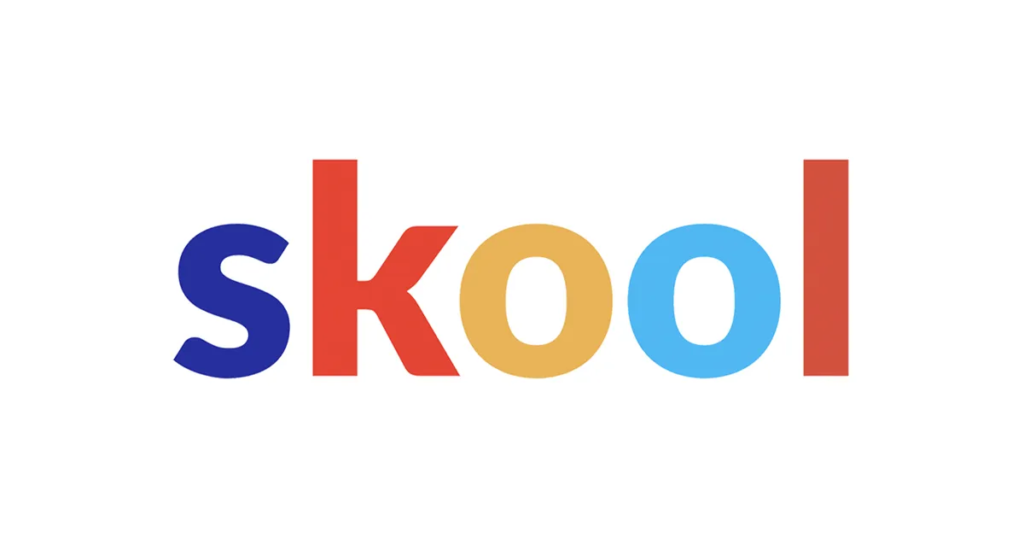
Skool goes beyond a simple Learning Management System (LMS). It’s a community-centric platform designed to empower creators to build engaging online courses and cultivate thriving communities around their expertise. Think of it as a one-stop shop for course creation, delivery, and fostering a passionate community of learners.
Who is Skool For?
Skool caters to a diverse range of creators, including:
- Course Creators: From established educators to aspiring entrepreneurs, Skool provides a robust platform for creating and delivering online courses.
- Coaches and Consultants: Build a membership site, offer coaching programs, and foster a supportive community for your clients within Skool.
- Community Builders: If fostering a thriving online space for like-minded individuals is your focus, Skool’s community features empower you to connect and engage your audience
So if you are a:
- Business owner
- Coach/Consultant
- Educator
- Course creator
- Youtuber
And you want to:
Teach or gather together people into a single, distraction and advertisement-free community, where you have complete control over all the content these people see.
Then Skool.com might be right for you.
Let’s dissect and review the Skool platform piece by piece, so you can make a well-informed decision whether it’s the right choice for you.
Key Features of Skool:
- Intuitive Course Creation Tools: Develop engaging courses with various content formats like videos, text lessons, quizzes, and assignments.
- Membership Functionality: Offer tiered membership options to cater to different learning needs and provide exclusive content for premium members.
- Live Events and Webinars: Host live sessions for interactive learning experiences and foster real-time connections within your community.
- Discussion Forums and Chat: Spark discussions, encourage peer-to-peer learning, and build a sense of belonging through robust communication features.
- Gamification Elements: Motivate learners and boost engagement with points, badges, and leaderboards.
- Built-in Analytics: Track key metrics like course completion rates, member activity, and engagement to gauge learning progress and refine your offerings.
- Integrations: Connect Skool with various tools like Zapier, allowing you to streamline workflows and automate tasks.
Within the community people can engage with each other via posts, likes, comments and direct chat messages:
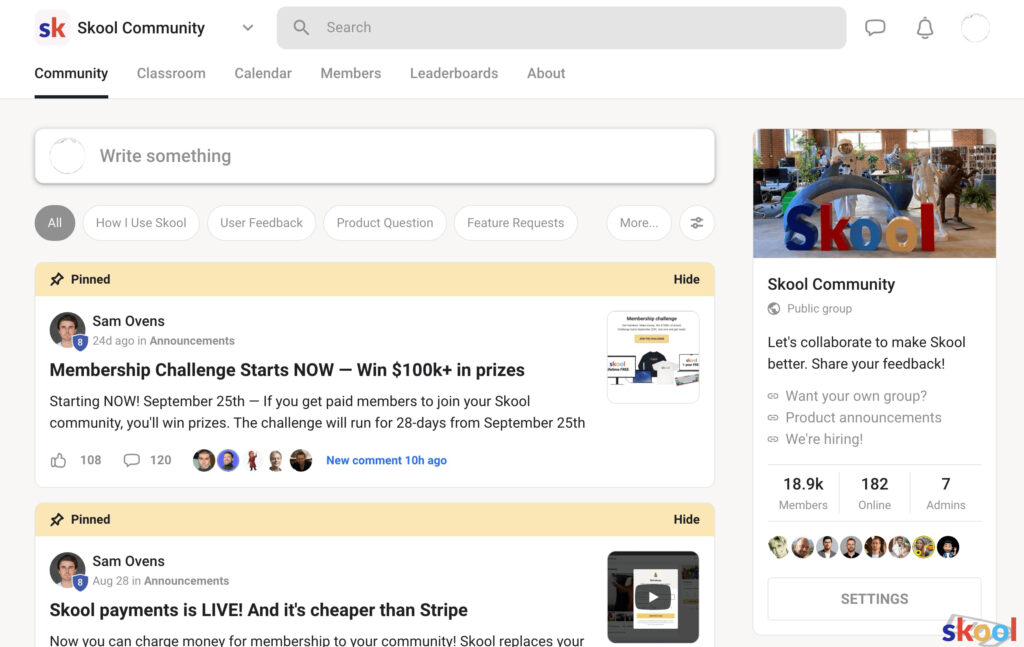
In the classroom your customers can learn by following your courses/training programs:
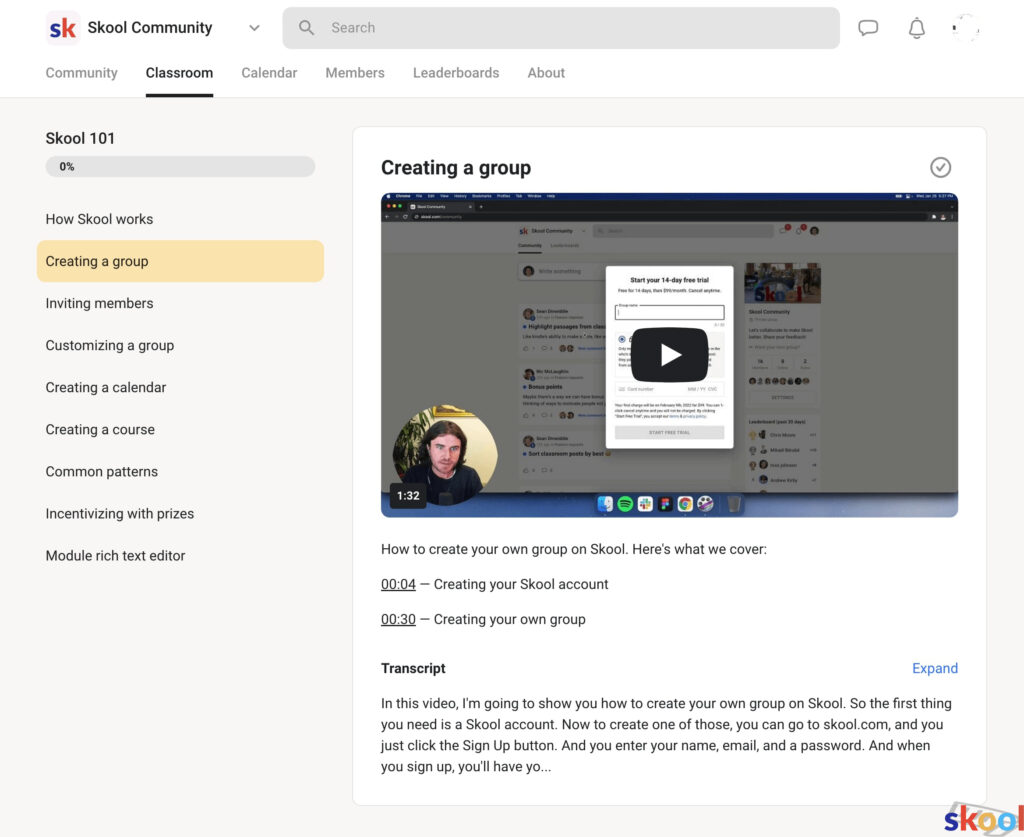
Via the calendar you can schedule online and offline events such as recurring calls, webinars and meetups for you and your members:
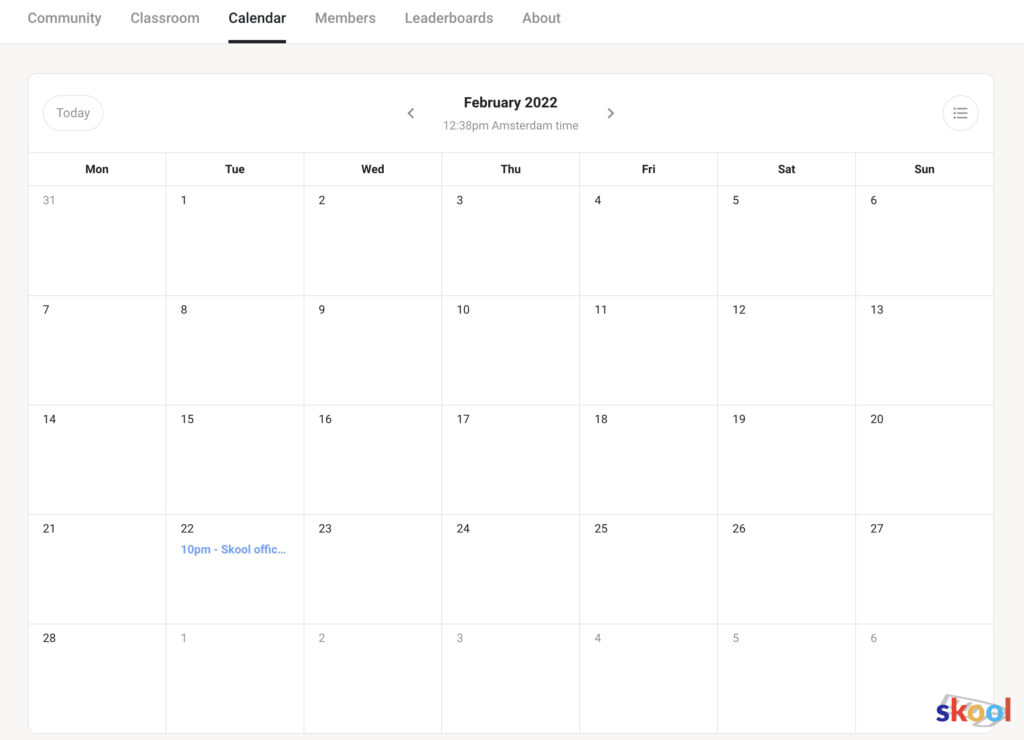
Gamification awards points to members for each ‘like’ they get on their posts/comments. Reach a certain amount of points and you ‘level up’. Rewards can be linked to each level to boost engagement.
Leaderboards show the most active members and rewards for each level:
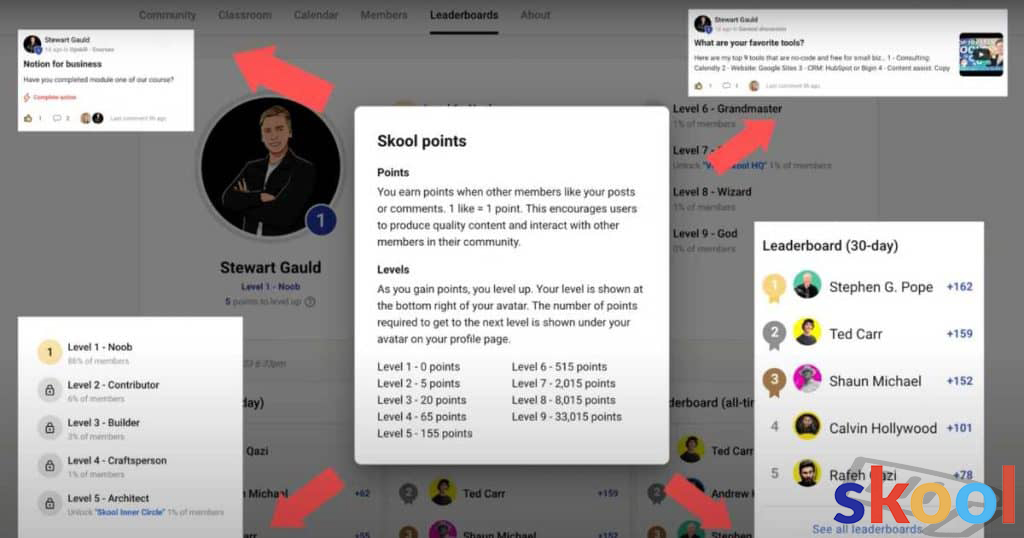
Feature #1 – The Community
The community of a Skool group looks like this:
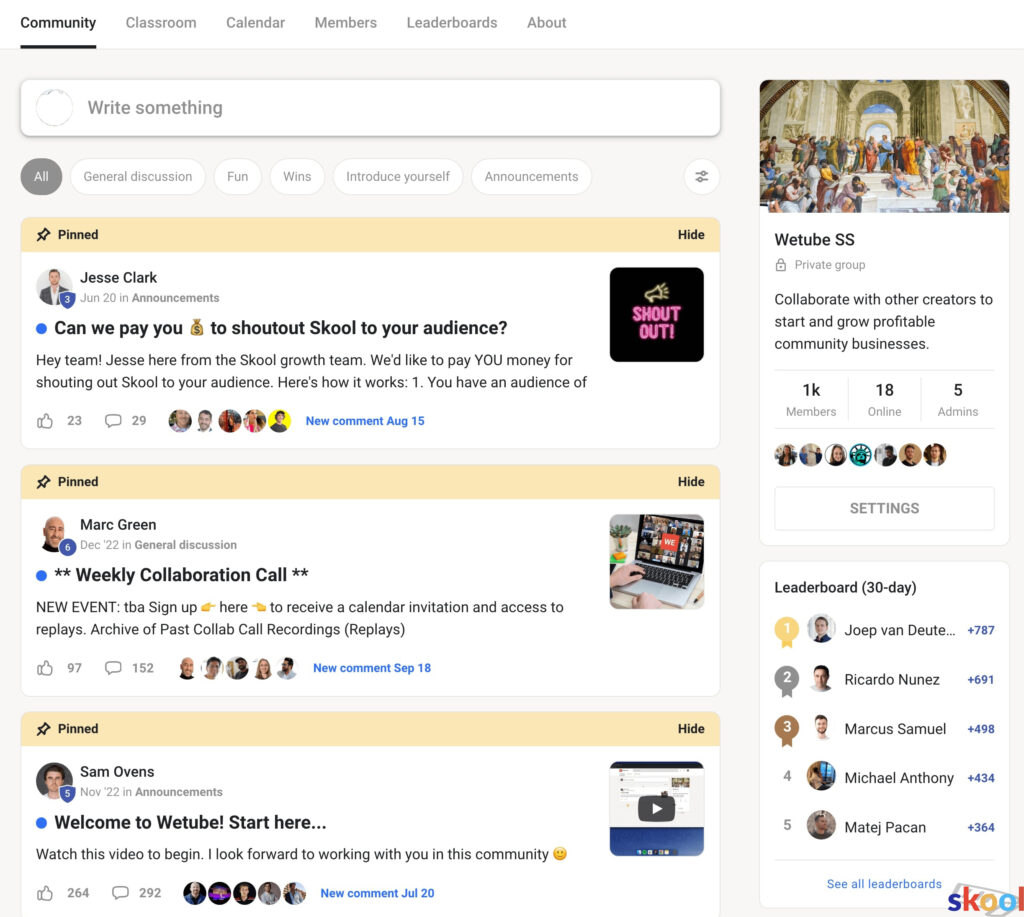
It’s a clean interface, where you can pretty much do two things:
- Post something yourself.
- Read and engage with posts of other members.
(more later on the types of posts you can do in a Skool community)
Here’s a screenshot of your average Facebook group:
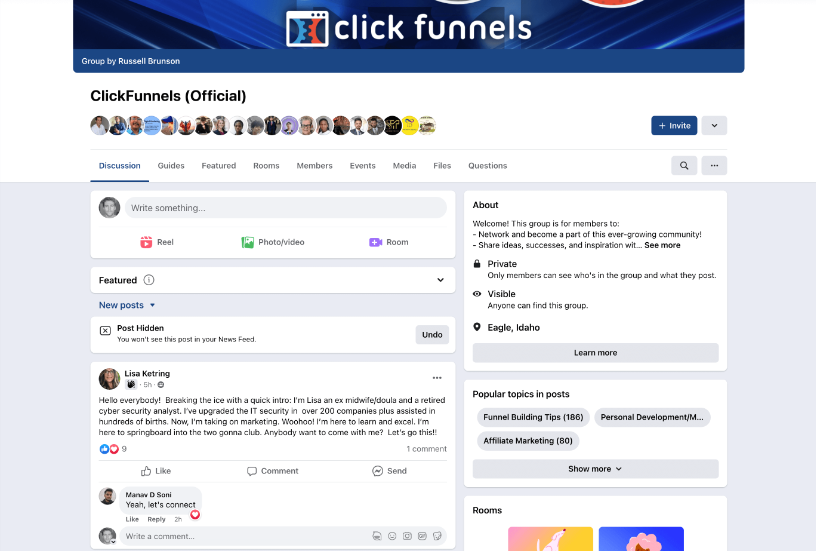
They look similar and you can post/engage with other people’s posts in a Facebook group too.
But on Facebook, there’s always so much going on.
Visiting Facebook and navigating to your group feels like navigating through a busy shopping street.
Something or someone is always fighting for your attention.
With Skool, as you log in, you simply land in a nice little oasis.
In the past 12 months I have always found it a nice experience to spend time in a Skool community. Both as a member, and as an admin.
Posting in a Skool community
Both members and admins can post in a Skool community.
You can attach files, images, GIFs and videos (YouTube, Vimeo, Loom, Wistia, or Bunny.net) to your post. It’s possible to run polls too.
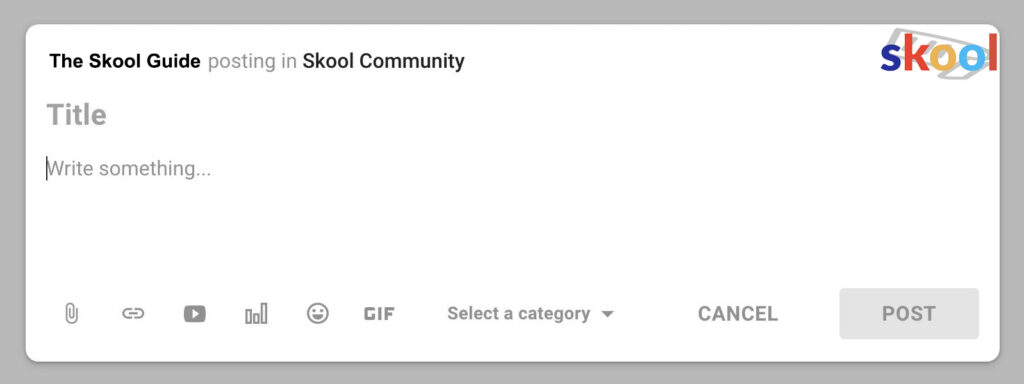
When posting something, you do so in a specific category.
This helps to keep posts organized. Your members can easily view posts by category via pill menu and use the filter button to sort posts, which is handy for finding specific information quickly:
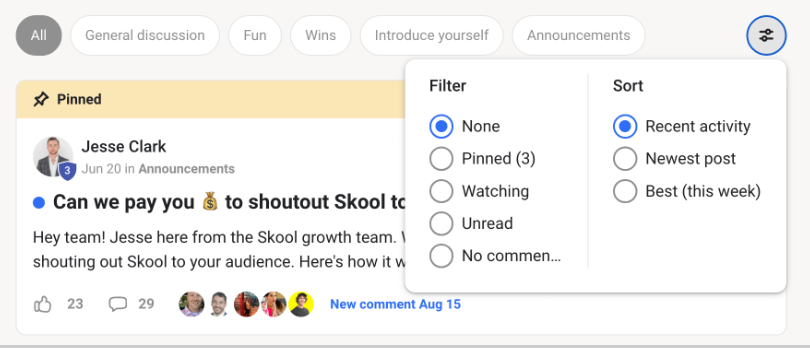
As an admin, you can set up categories as you like.
You even can set up specific categories where only you as an admin can post, and your members can only view posts.
Skool Community feature – In conclusion
Skool delivers when it comes to the necessary elements needed to build a thriving community:
For members, they offer a supportive environment without distractions where you can engage and connect with other members, feel accountable and consistently work towards a common goal and even specific rewards.
The chat feature allows members to privately connect with other members as well as admins to discuss specific topics and exchange knowledge which facilitates the building of relationships even further.
Also “time to value” is extremely fast. When entering a new community the learning curve is about 3 seconds.
For admins, they’re simple to set up, easy to use, low maintenance, and more importantly, you can make them fun with gamification.
Feature #2 – The Classroom
The classroom is the second main feature of a Skool group.
This is where your members can follow your courses.
It looks like this:
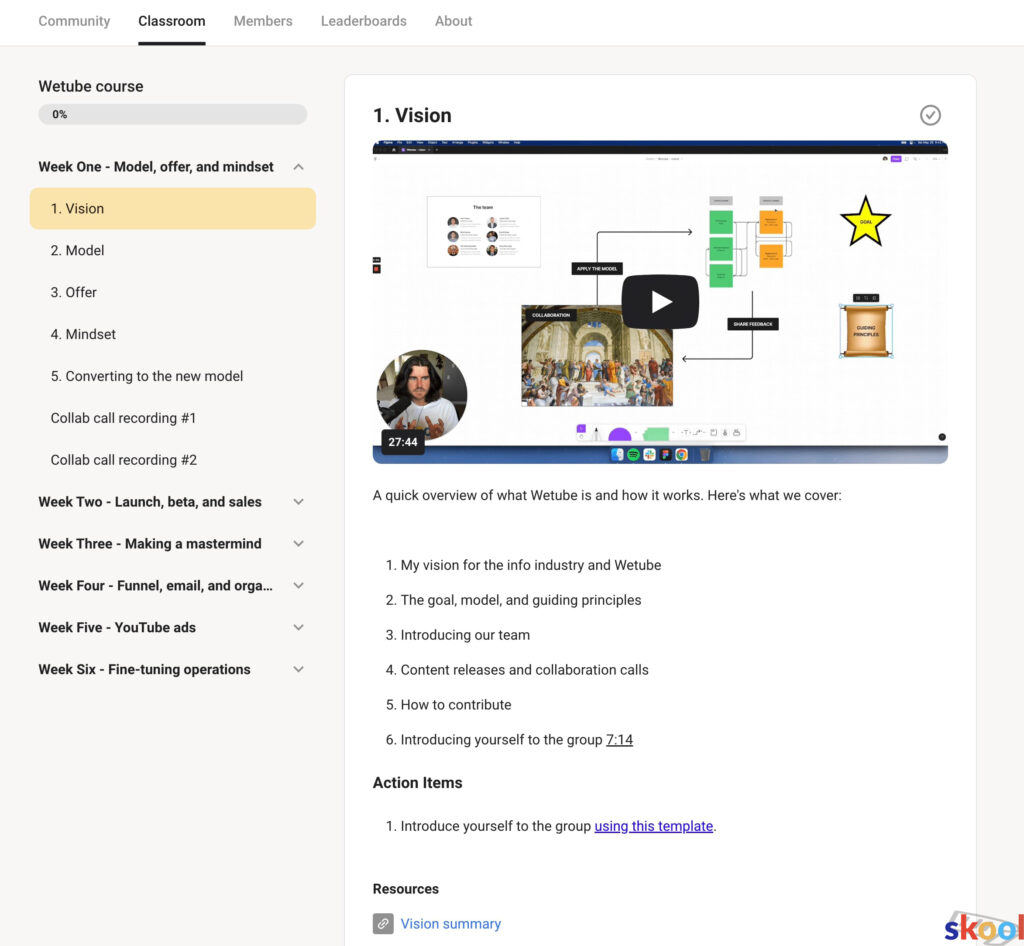
If you add more than one course, members will first have to select which course they’d like to see when visiting the classroom tab:
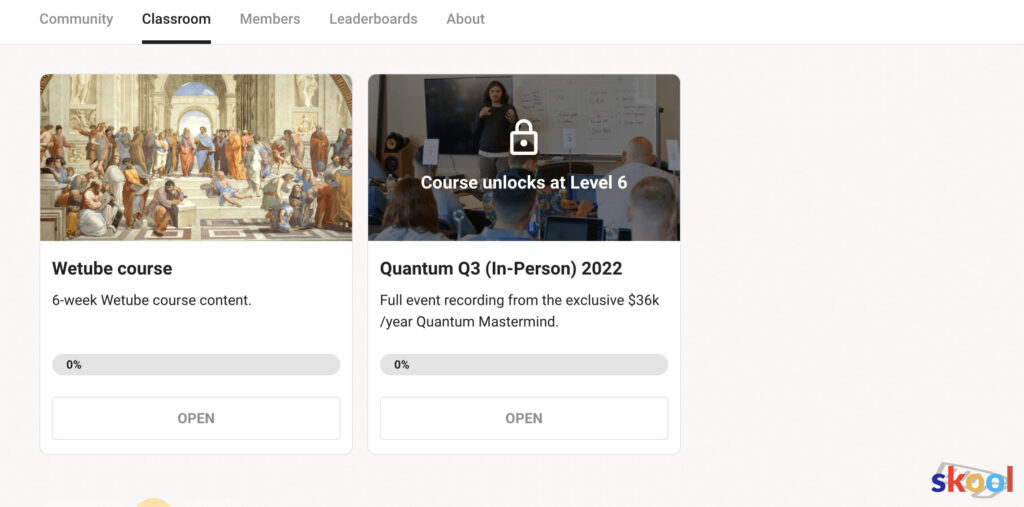
You can add as many courses to the classroom as you like.
Note: if you don’t add any courses to your group, the classroom tab will be hidden.
Setting up your course(s) is easy
Setting up your course takes a few minutes, via the classroom tab you simply add a new course.
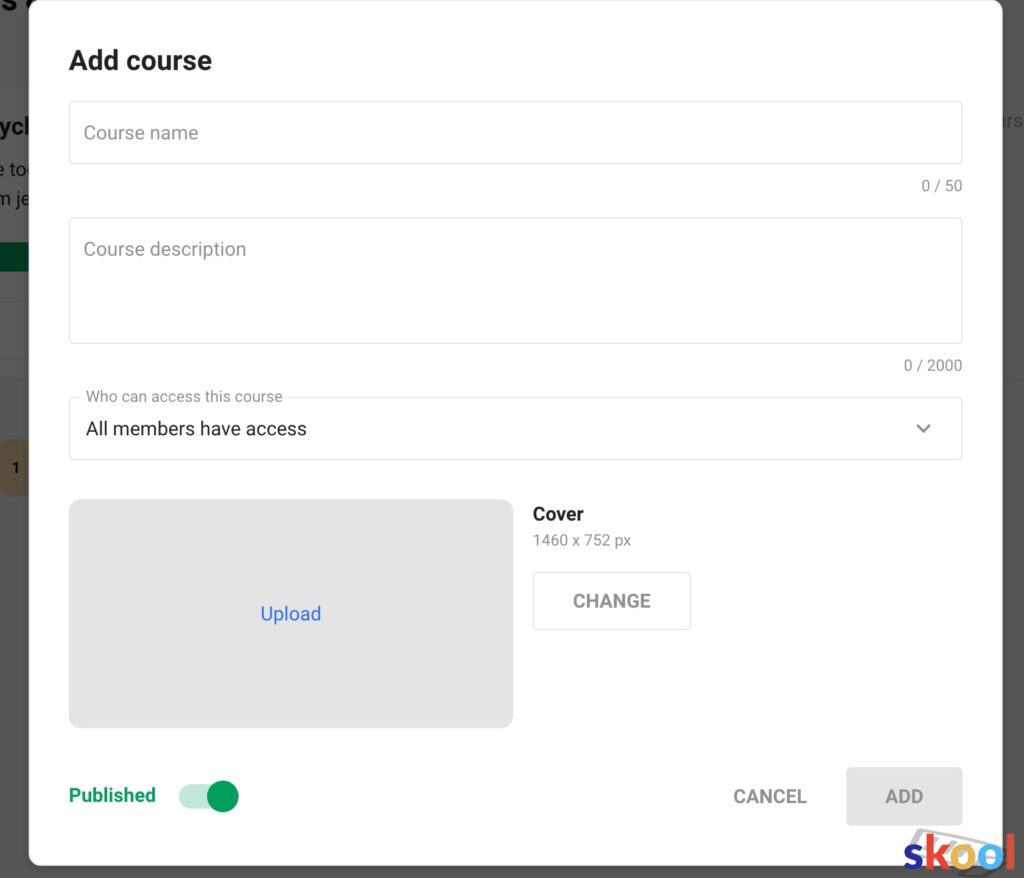
Access to a course can be set to:
- All members have access
- Only some members have access
- Members of a certain level have access
If members of a certain level have access, you can decide which level members have to reach in order for the course to be unlocked in the classroom.
(reaching a level ties into the gamification aspect, more on that in a minute at feature #4)
Next, you simply use the inline/drag-and-drop editor to add and arrange the modules in your course:
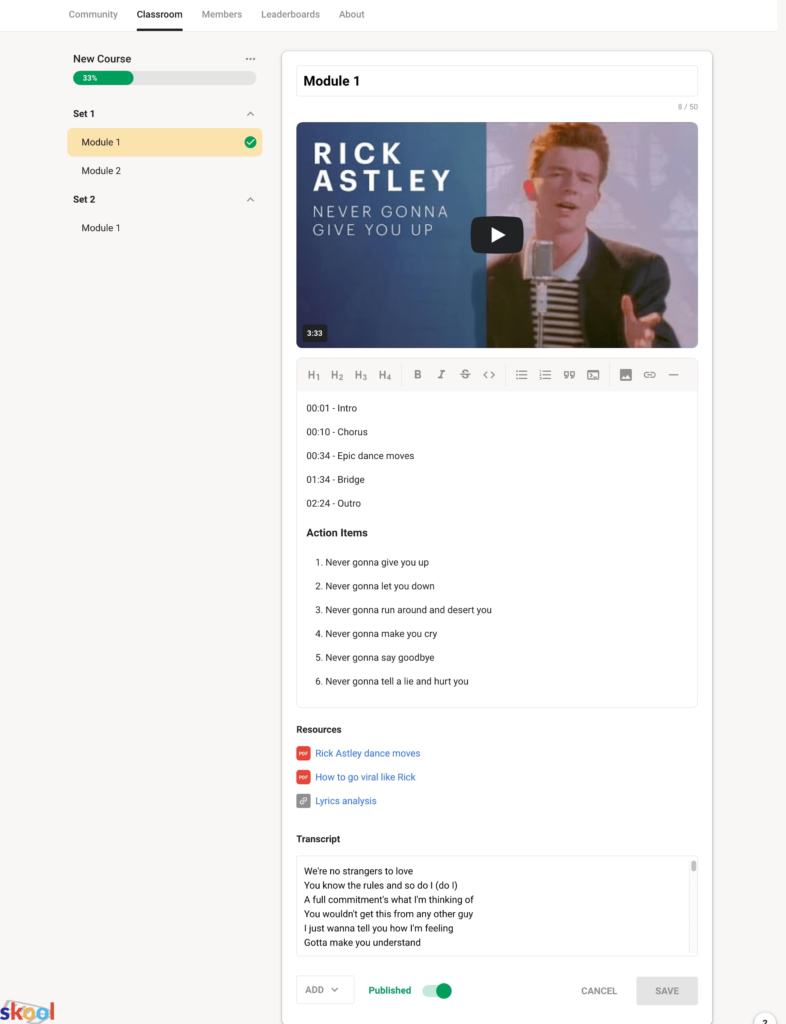
Each module can include:
- One video
- Description (linked video timestamps are supported)
- Multiple links
- Multiple files
- Actions items
- Transcript (this makes video content searchable)
- Drip release to delay access (can be turned on/off per module)
Skool (as of yet) doesn’t offer video hosting, so you will have to upload your videos to either YouTube/Vimeo/Wistia/Loom/Bunny.net and enter the link while setting up a module:
Skool Classroom feature – In conclusion
Skool’s Classroom feature makes online learning smooth sailing for both students and instructors.
Students will appreciate:
- Effortless Navigation: The Classroom is well-organized and intuitive, allowing you to jump right into learning without getting lost.
- Straightforward Interface: No need for manuals! Skool’s Classroom is designed to be user-friendly from the get-go.
Instructors can benefit from:
- Quick Course Setup: Setting up your course takes just minutes. The interface is straightforward, so you can skip the tutorials and get started right away.
- Flexible Course Design: Craft your course exactly how you envision it. You can add descriptions, timestamps, files, links, action items, and even transcripts for each module.
- Clean and Organized Layout: The default layout keeps things clear and easy to follow for students. While you can’t customize the layout itself, most instructors find it works well as is.
Keep in mind:
- External Video Hosting: You’ll need to use a separate service like YouTube or Vimeo to host your videos. Skool doesn’t offer built-in video hosting.
- Limited Assessment Tools: Currently, Skool doesn’t have quizzes or tests within the Classroom feature. If you want to test your students’ knowledge, you’ll need to integrate a separate tool like Typeform.
Feature #3 – The Calendar
The third main feature of a Skool group is the calendar feature, which looks like this:
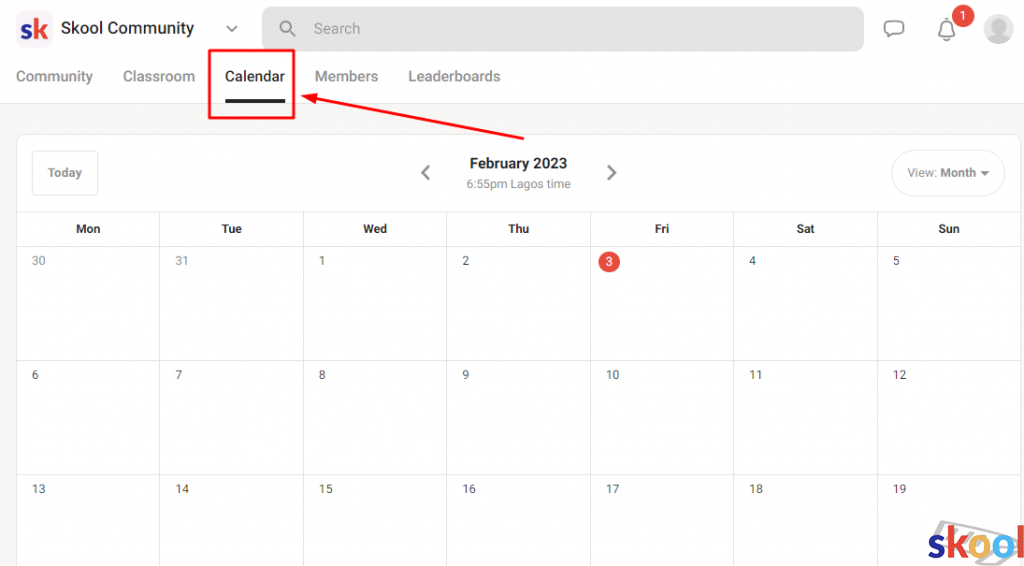
It’s basically a public agenda where you can schedule (recurring) online and offline events for all your members to see.
Note: if you don’t add any events to your group, the calendar tab will be hidden until you add one.
Scheduling an event works intuitively and is similar to Google Calendar:
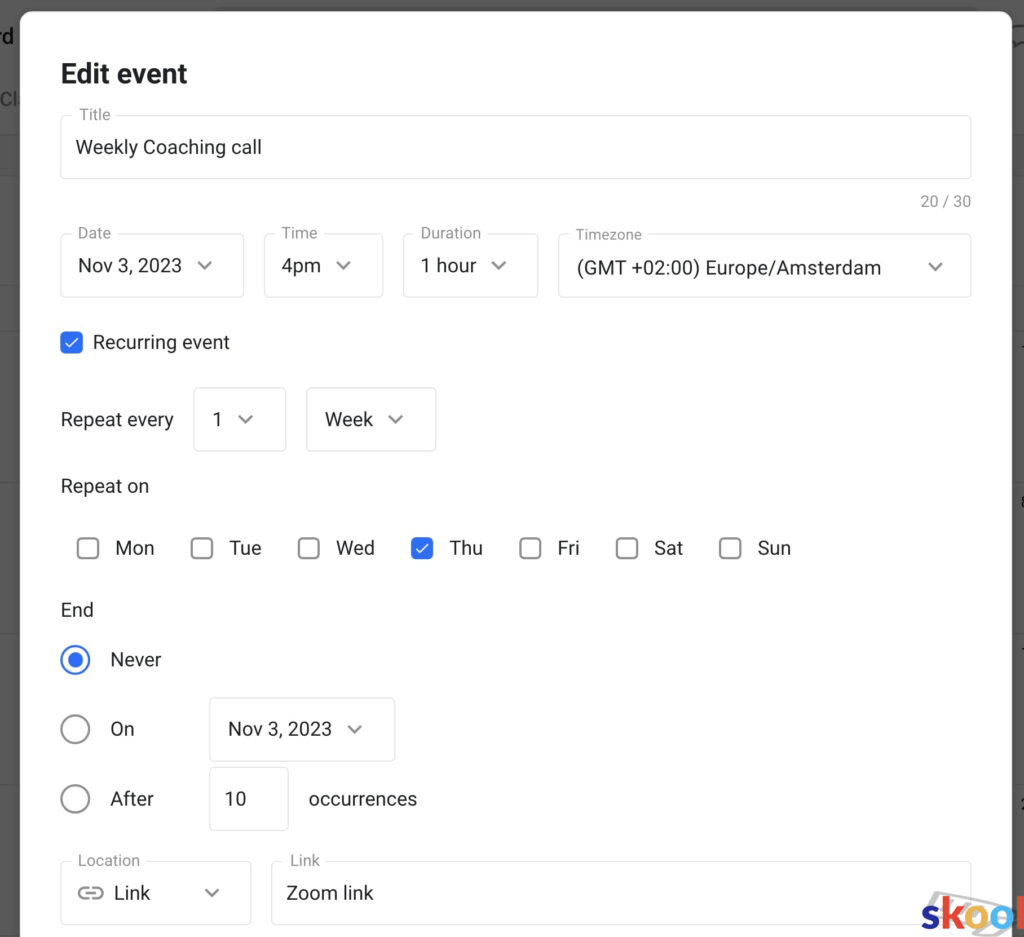
Simply enter a title and choose the date, time, duration and timezone for your event.
You can also choose to send your members an email 24 hours prior to the calendar event (this works very well to increase show-up rate).
Note: you still need a tool like Zoom or Google Meets to run the meeting. Skool doesn’t offer this service.
The time of the event is automatically converted to the timezone of each individual member too.
Finally no more confusion about timezones!
Members can click on the event to view the description or to add the event to an external calendar like Google, Apple, Outlook, Outlook.com and Yahoo:
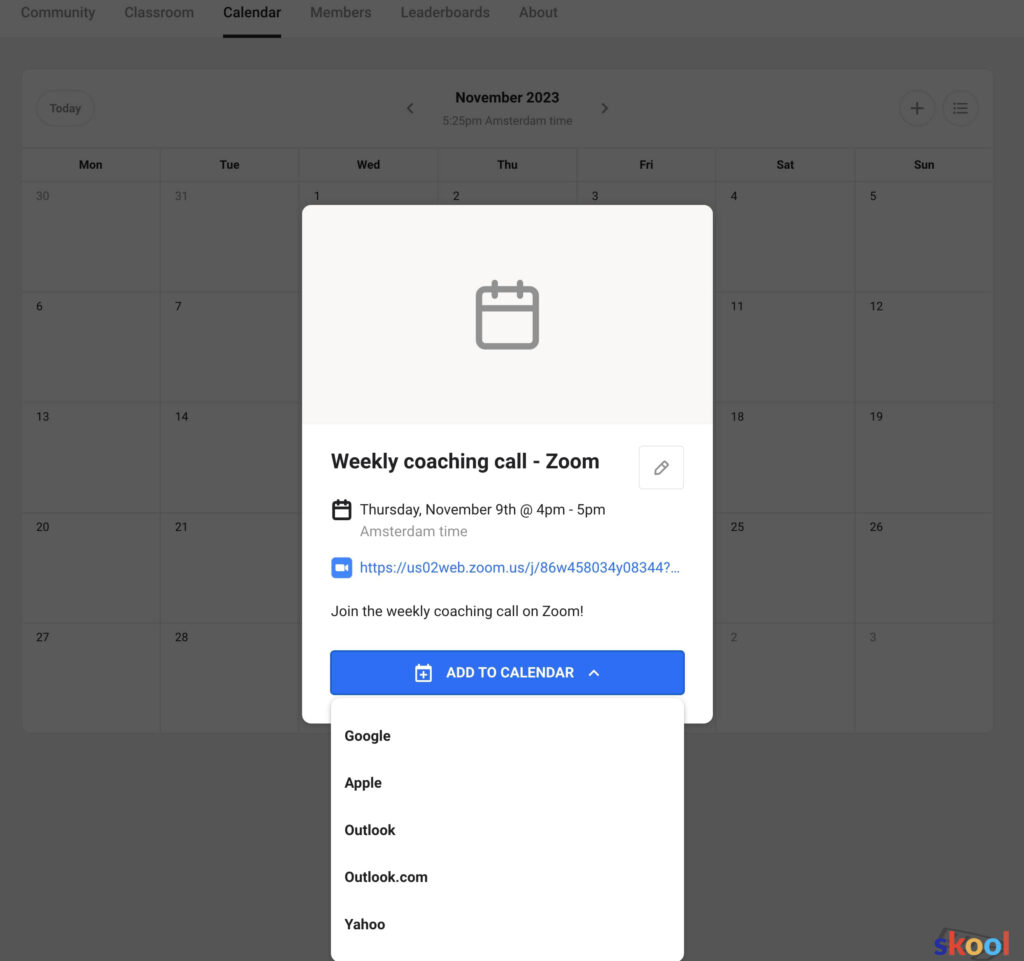
The event that’s coming up next is also highlighted in the community to tab:
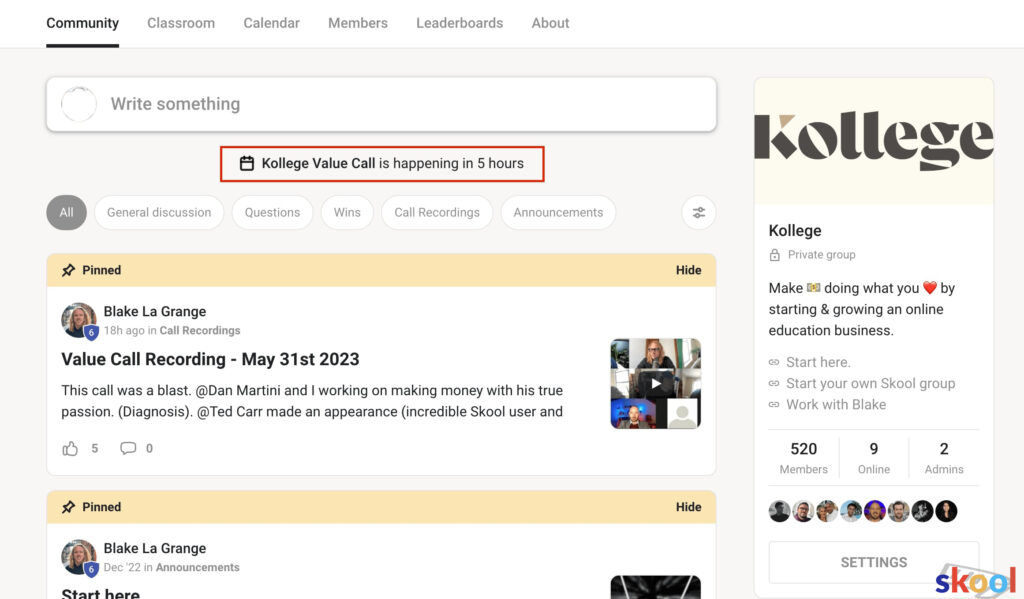
If you click on it, you go straight to the details of the event, pretty nice!
Tip: If you run Q&A calls, record them and post them in a designated category in the community, so your members can go back and view the recording whenever they want.
You can even go all out and have your Q&A calls transcribed, which will make them searchable via Skool’s search feature!
Skool Calendar feature – In conclusion
The calendar feature is simple, but adds a ton of value to the entire experience of Skool.
For members, it’s easy to see when events are coming up and accessing them is usually just a few clicks away.
Automatic timezone conversion instantly makes it clear when events happen, no matter where you are in the world.
Forgetting about an event happens rarely with the email reminder, add to calendar feature and notification in the community tab.
For admins, setting up events is done in a few clicks. Expect to receive much less to possibly even zero questions about when events happen or how to access them.
Besides that, show up rates are boosted without any effort from your side with an email reminder and notification in the community tab.
Feature #4 – Gamification:
Now onto one of the coolest features, gamification.
If a member posts or comments something valuable, other community members can like that post/comment:
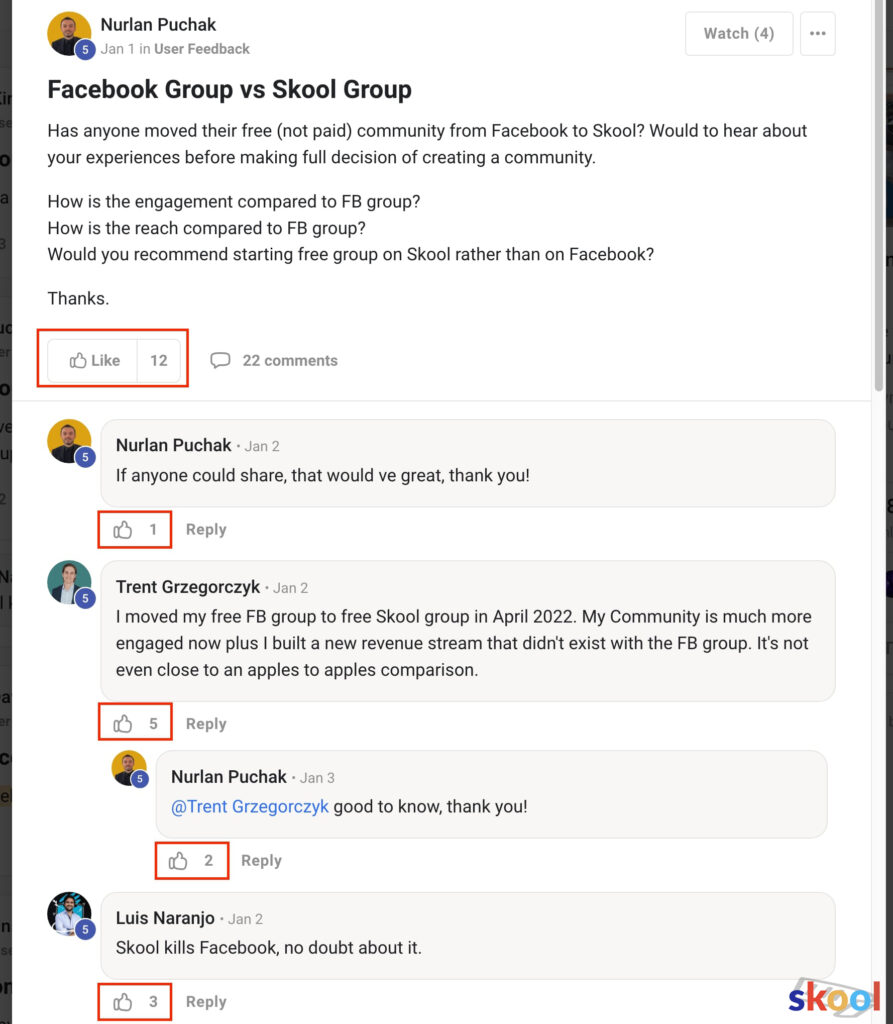
Likes translate into points which are linked to a level connected to a user’s profile.
(Sam Ovens is currently level 5 in this specific Skool group).
Reach a certain amount of points, and you level up (there are 9 levels, which you can also give custom names to).
Community members who gather the most points (by adding the most value to your community) are listed on the leaderboards of your Skool group:
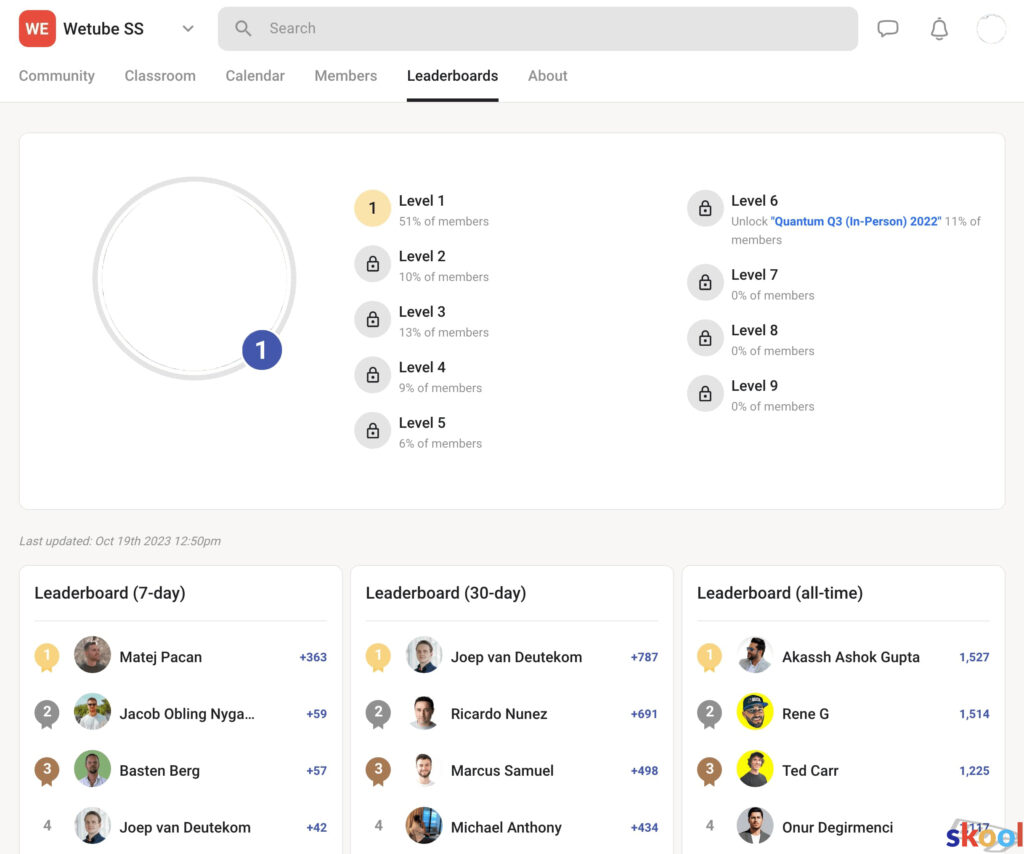
As an admin, you can connect rewards to each specific level.
For example, when you reach level 6 in the group in the screenshot above, you unlock access to “Quantum Q3 (in-Person) 2022’, which is a recording of a mastermind event.
Reach level 6, and the course will automatically become available in the classroom tab of the same group.
Besides unlocking content in the classroom, you can pretty much give any reward you like.
You could for example give away a free 1-on-1 coaching call to the #1 person on the 30-day leaderboard each month.
Skool Gamification feature – In conclusion
Skool’s gamification feature is a game-changer (pun intended!) for boosting community engagement.
Here’s why it works so well:
- Built-in Motivation: Rewards incentivize members to participate actively, adding value to the community.
- Healthy Competition: The leaderboard lets members see their progress and compare themselves to others, fostering a friendly competitive spirit.
- Focus on Quality: Members naturally gravitate towards actions that contribute meaningfully, as the community itself determines what’s valuable. This prevents spammy tactics to gain points.
Overall, Skool’s gamification features are a low-effort way to significantly increase engagement within your online community.

Pros of Skool:
- Focus on Community Building: Skool prioritizes fostering a sense of community, which can lead to higher engagement and learner satisfaction.
- Easy-to-Use Interface: The platform is intuitive and user-friendly, making it accessible for creators with varying technical skills.
- Flexibility and Customization: Skool offers a high degree of customization, allowing you to tailor the learning experience to your specific needs and brand.
- All-in-One Platform: Streamline your workflow by managing courses, memberships, and communities all within Skool.
- Engaging Features: Gamification elements, live sessions, and robust communication tools keep learners motivated and actively participating.
Cons of Skool:
- Pricing: Compared to some LMS platforms, Skool’s pricing can be higher, especially for those just starting out.
- Limited Marketing Features: While Skool offers basic community promotion tools, creators seeking extensive marketing functionalities might need additional integrations.
- Newer Platform: As a relatively newer platform compared to established LMS giants, Skool might have a smaller pool of resources and integrations.
Skool Cost and Pricing:
Skool pricing is as simple as the software itself.
There’s one plan with everything included which costs $99 /month.
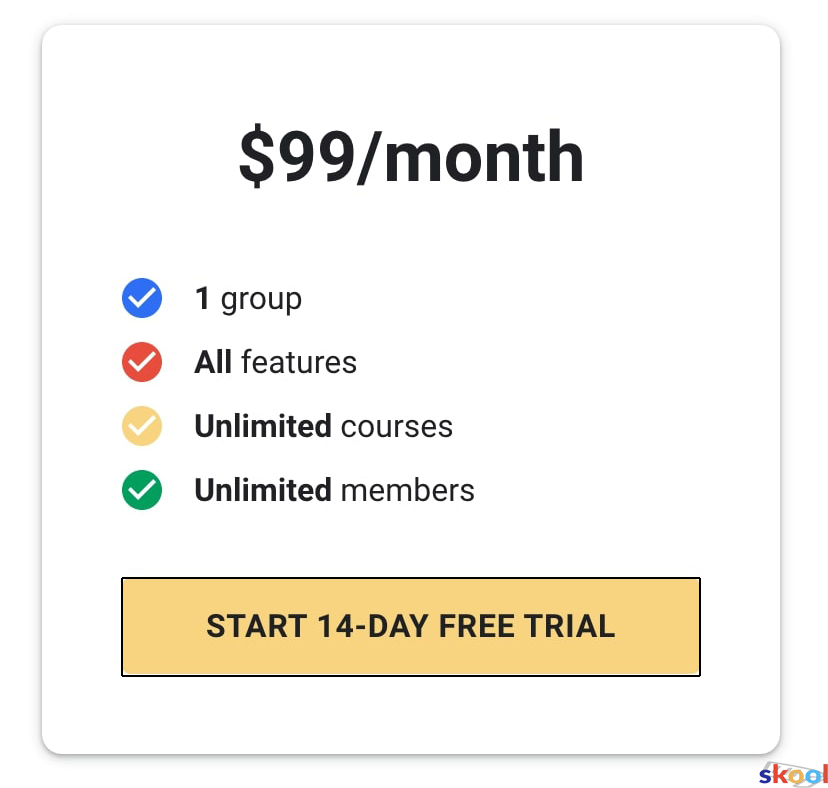
Note that this is the price per group.
If you want multiple Skool groups, you’ll have to pay $99 /month per group.
Skool does offer a free 14-day trial via this link.
Currently, there is no free plan.
Skool Discount and Special Deals
Currently there are no discounts or special deals available for Skool.com.
But as soon as there are, I’ll make sure to update this post accordingly.
The best deal you can get at the moment is the free 14-day trial.
Is Skool Right for You?
If you prioritize building a thriving online community alongside your course content and value an intuitive and user-friendly platform, Skool could be an excellent fit. However, if budget is a major concern, or you require extensive marketing functionalities, exploring other LMS options might be prudent.
Is Skool com Legit?
Yes, Skool.com is a legitimate platform for building online communities and courses. Here’s why:
- Established Founder: Skool was founded by Sam Ovens, a well-known figure in the online course and coaching space.
- Positive Reviews: Reviews of Skool generally point to its user-friendly interface, strong community features, and focus on fostering learner engagement.
- Active Development: Skool is actively being developed, with new features and improvements being rolled out regularly.
Alternatives to Skool:
Here are some popular LMS platforms to consider:
- Teachable: A user-friendly platform with a strong focus on course creation and sales.
- Thinkific: Another creator-friendly platform with robust course creation tools and marketing functionalities.
- Podia: An all-in-one platform offering memberships, courses, email marketing, and community features.
- Kajabi: A comprehensive platform with powerful marketing tools, sales funnels, and course creation functionalities.
Ultimately, the best platform for you depends on your specific needs and priorities. Consider the features, pricing, and target audience of each platform before making your decision.
Skool offers a free 14-day trial, allowing you to explore the platform firsthand and see if it aligns with your vision. With its emphasis on community building and user-friendly interface, Skool has the potential to be a powerful tool for creators seeking to cultivate a vibrant online space for learning and connection.
FAQs about Skool
Q: Who can benefit from using Skool?
A: Skool is ideal for educators, course creators, and businesses looking to build interactive learning communities and provide engaging online courses.
Q: How does Skool promote community engagement?
A: Skool uses forums, group discussions, and gamification features like points and leaderboards to encourage active participation and interaction among learners.
Q: What are the main features of Skool?
A: Skool offers course hosting, community forums, progress tracking, gamification elements, and integrations with various tools to streamline the learning process.
Q: Can I integrate Skool with other tools?
A: Yes, Skool integrates with popular tools like Zoom, Stripe, and various email marketing platforms, making it easy to manage and enhance your learning environment.
Q: Is Skool suitable for large organizations?
A: Yes, Skool is scalable and can accommodate the needs of both small teams and large organizations, offering robust features to manage multiple courses and communities.
Q: What are the pricing plans for Skool?
A: Skool offers various pricing plans to suit different needs and budgets. It typically includes a free trial period, followed by subscription-based plans with additional features.
Q: How does Skool compare to other LMS platforms?
A: Skool stands out for its strong focus on community and engagement, while other platforms might prioritize content delivery or corporate training features.
Q: Can I try Skool platform before committing to a plan?
A: Yes, Skool usually offers a free trial period, allowing you to explore its features and see if it meets your needs before committing to a subscription.

